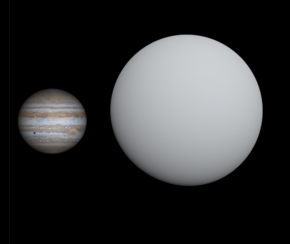XO-6bis a transitingexoplanet,ahot Jupiter,orbiting the star XO-6 around 760light years(230parsecs) away from Earth. It was discovered in 2016 by theXO planet search team.[3][4]
 Jupitercompared to XO-6b | |
| Discovery[1] | |
|---|---|
| Discovery site | Haleakalā ObservatoryinMaui,Hawaii |
| Discovery date | December 8th, 2016 |
| Transit | |
| Orbital characteristics[2] | |
| 0.0412±0.002AU | |
| Eccentricity | 0.00 (fixed)[1] |
| 3.7649923+45 −46d | |
| Inclination | 84.77°+0.82° −0.66° |
| 2,458,843.93943±0.00012JD[1] | |
| Semi-amplitude | <450m/s[1] |
| Physical characteristics[2] | |
| 2.17±0.20RJ | |
| Mass | 1.73±0.20MJ |
| Temperature | 1,670±25K |
Physical properties
editXO-6b is one of the puffiest planets ever discovered, with a maximum mass of 4.4 times of Jupiter. It is over twice as wide, making it one of the largest exoplanets ever found (seelist of largest exoplanets). Later estimates, however, make it around two times the mass of Jupiter.[3][4]
XO-6b has a tight orbit, which means ayearon it is only about 4 days. XO-6 is slightly more than one-tenth as far from its host star asMercuryis to the sun.
XO-6
editXO-6b orbits XO-6, a faint 10th magnitude star in the constellationCamelopardalis.[5]Due to its magnitude, this star is too faint to be seen with the naked eye, but can be seen with a telescope.[citation needed]XO-6 is aF-type main-sequence starwith about 1.5 times the mass of theSun.It is also radiating 4 times as bright, and is almost twice the size of the Sun. It is also hotter, with a temperature of 6720kelvins,which gives it the typical hue of an F-type star.[3]Unlike most other stars of its kind, XO-6 rotates rapidly at a rate of 43 km/s.
References
edit- ^abcdCrouzet, N.; et al. (2017)."Discovery of XO-6b: A Hot Jupiter Transiting a Fast Rotating F5 Star on an Oblique Orbit".The Astronomical Journal.153(3). 94.arXiv:1612.02776.Bibcode:2017AJ....153...94C.doi:10.3847/1538-3881/153/3/94.S2CID119082666.
- ^abSaha, Suman (2024-09-01)."Precise Transit Photometry Using TESS. II. Revisiting 28 Additional Transiting Systems with Updated Physical Properties".The Astrophysical Journal Supplement Series.274(1): 13.arXiv:2407.20846.Bibcode:2024ApJS..274...13S.doi:10.3847/1538-4365/ad6a60.ISSN0067-0049.
- ^abcBrown, A. G. A; et al. (2016)."Gaia Data Release 1. Summary of the astrometric, photometric, and survey properties".Astronomy and Astrophysics.595.A2.arXiv:1609.04172.Bibcode:2016A&A...595A...2G.doi:10.1051/0004-6361/201629512.S2CID1828208.Gaia Data Release 1 catalog entry
- ^ab"The Extrasolar Planet Encyclopaedia — XO-6 b".Extrasolar Planets Encyclopaedia.2016.Retrieved2021-02-18.
- ^"Find the constellation which contains given sky coordinates".djm.cc.Retrieved2021-02-14.
Further reading
edit- Garai, Zoltán; et al. (January 2020)."Periodic transit timing variations and refined system parameters of the exoplanet XO-6b".Monthly Notices of the Royal Astronomical Society.491(2): 2760–2769.arXiv:1911.07054.Bibcode:2020MNRAS.491.2760G.doi:10.1093/mnras/stz3235.
- Ridden-Harper, Andrew; Turner, Jake D.; Jayawardhana, Ray (December 2020)."TESS Observations of the Hot Jupiter Exoplanet XO-6b: No Evidence of Transit Timing Variations".The Astronomical Journal.160(6): 249.arXiv:2009.10781.Bibcode:2020AJ....160..249R.doi:10.3847/1538-3881/abba1e.S2CID221856652.